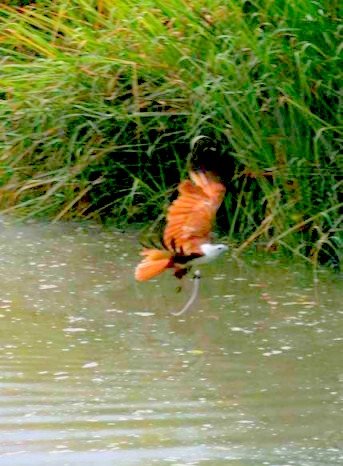
The Plight of Sea Eagle
Memories of the holiday we took in February have to jogged by some out of focus snaps, souvenirs skulking in drawers, having never found a suitable shelf or wall to display them on.
The guilt is gone for never having contacted the couple we spent practically every day on the beach with or the “very nice Americans” who were our travelling companions on the train we took to Penang.
However, one thing that remains all too clear in my mind is the heartbreaking sight we saw on an excursion to the Mangroves.We had spent an extraordinary day with our guide, a passionate environmentalist, who had fascinated us with his explanations and history of the many and varied treasures of the natural world in Langkawi.
Largely ignorant of the ways of the rainforest and the infrastructure it supports we were fascinated to learn that many species, both plant and animal, were unique to Langkawi. Sadly a large percentage of the rainforest has already been sacrificed in order to accommodate tourists.
Tourists are of course essential to the economy of the island but hopefully a compromise can be reached and large hotel complexes will be restricted before Langkawi is reduced to yet another faceless island with a nice beach and lots of shops.
Returning from our excursion by boat to the jetty we passed a square wooden pontoon, it looked like the kind of thing used by swimmers, but how odd? This was miles from any hotels or houses. The guide sadly told us that this was used on popular tourist attraction. An excursion called “feeding the sea eagles”.
Apparently guides would scatter the pontoon with chicken entrails and then sat around on their boats with tourists waiting for the eagles to appear. As our boat approached the pontoon we witnessed a most extraordinary sight – within minutes of our arrival the sky filled with sea eagles. There were around 30 to 40 birds circling waiting to be fed.
We were told that this excursion was legal and condoned by the government. It was advertised at the hotels as a recommended excursion. The effect on feeding the eagles with an unnatural diet was already showing its toll. Birds had been discovered loosing their plumage and becoming weak due to lack of nutrients. Even the shells of un-hatched eggs were too weak and were breaking before the fledglings hatched causing depletion in numbers – in other words the birds were being domesticated and becoming rapidly endangered.
The first time we had seen a sea eagle was whilst sitting on the beach and it was a wonderful sight to see this majestic bird soaring over the sea before swooping to catch a fish. This bird is systematically being stripped of its dignity and being made to perform and beg for its food. If this abominable event is allowed to continue the sea eagle will no doubt become yet another victim to man’s desire to see nature from an armchair.
I was brought up in a city, only ever owned a cat, can hardly be described as an animal rights fanatic but I do feel strongly about this and implore whoever is in a position to do something about ending this activity to do it immediately.
In closing I would say that the independent excursion guides, Irshad and Peter, are to be highly commended for their knowledge, enthusiasm and obvious respect for the magnificent treasures to be found in the Langkawi Rainforest. May they long continue to educate travelers to the island.
By Sandra King/Nigel Carter Guernsey – March 2004



